
Parasailing, also known as parascending, paraskiing orparakiting, is a recreational kiting activity where a person is towed behind a vehicle while attached to a specially designed canopy wing that resembles a parachute, known as a parasail wing. The manned kite's moving anchor may be a car, truck, or boat. The harness attaches the occupant to the parasail, which is connected to the boat, or land vehicle, by the tow rope. The vehicle then drives off, carrying the parascender and person into the air. If the boat is powerful enough, two or three people can parasail behind it at the same time. The parascender has little or no control over the parachute. The activity is primarily a fun ride, not to be confused with the sport of paragliding.

A scuba set is any breathing apparatus that is carried entirely by an underwater diver and provides the diver with breathing gas at the ambient pressure. Scuba is an anacronym for self-contained underwater breathing apparatus. Although strictly speaking the scuba set is only the diving equipment which is required for providing breathing gas to the diver, general usage includes the harness by which it is carried, and those accessories which are integral parts of the harness and breathing apparatus assembly, such as a jacket or wing style buoyancy compensator and instruments mounted in a combined housing with the pressure gauge, and in the looser sense it has been used to refer to any diving equipment used by the scuba diver, though this would more commonly and accurately be termed scuba equipment or scuba gear. Scuba is overwhelmingly the most common underwater breathing system used by recreational divers and is also used in professional diving when it provides advantages, usually of mobility and range, over surface supplied diving systems, and is allowed by the relevant code of practice.
Sustainable living describes a lifestyle that attempts to reduce an individual's or society's use of the Earth's natural resources, and one's personal resources. It is often called "earth harmony living" or "net zero living". Its practitioners often attempt to reduce their ecological footprint by altering their methods of transportation, energy consumption and diet. Its proponents aim to conduct their lives in ways that are consistent with sustainability, naturally balanced, and respectful of humanity's symbiotic relationship with the Earth's natural ecology. The practice and general philosophy of ecological living closely follows the overall principles of sustainable development.
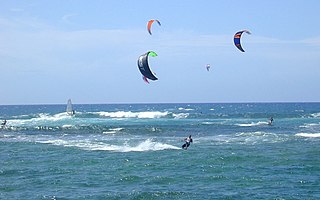
A power kite or traction kite is a large kite designed to provide significant pull to the user.

A buoyancy compensator, also called a buoyancy control device, BC, BCD, stabilizer, stabilisor, stab jacket, wing or ABLJ depending on design, is a piece of diving equipment which is worn by divers to establish neutral buoyancy underwater and positive buoyancy at the surface, when needed.

Surface-supplied diving is diving using equipment supplied with breathing gas using a diver's umbilical from the surface, either from the shore or from a diving support vessel, sometimes indirectly via a diving bell. This is different from scuba diving, where the diver's breathing equipment is completely self-contained and there is no link to the surface. The primary advantages of conventional surface supplied diving are lower risk of drowning and considerably larger breathing gas supply than scuba, allowing longer working periods and safer decompression. Disadvantages are the absolute limitation on diver mobility imposed by the length of the umbilical, encumbrance by the umbilical, and high logistical and equipment costs compared with scuba. The disadvantages restrict use of this mode of diving to applications where the diver operates within a small area, which is common in commercial diving work.
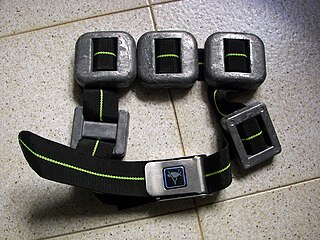
A diving weighting system is ballast weight added to a diver or diving equipment to counteract excess buoyancy. They may be used by divers or on equipment such as diving bells, submersibles or camera housings.

The buddy check is a procedure carried out by scuba divers using the buddy system where each diver checks that the other's diving equipment is configured and functioning correctly just before the start of the dive. A study of pre-dive equipment checks done by individual divers showed that divers often fail to recognize common equipment faults. By checking each other's equipment as well as their own, it is thought to be more likely that these faults will be identified prior to the start of the dive.
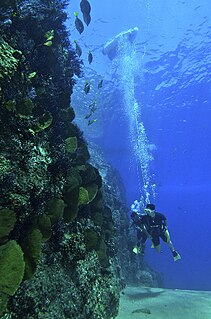
Snuba is form of surface-supplied diving that uses an underwater breathing system developed by Snuba International. The origin of the word "Snuba" may be a portmanteau of "snorkel" and "scuba", as it bridges the gap between the two. Alternatively, some have identified the term as an acronym for "Surface Nexus Underwater Breathing Apparatus", though this may have been ascribed retroactively to fit the portmanteau. The swimmer uses swimfins, a diving mask, weights, and diving regulator as in scuba diving. Instead of coming from tanks strapped to the diver's back, air is supplied from long hoses connected to compressed air cylinders contained in a specially designed flotation device at the surface. Snuba often serves as a form of introductory diving, in the presence of a professionally trained guide, but requires no scuba certification.
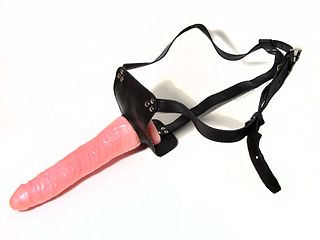
A strap-on dildo is a dildo designed to be worn, usually with a harness, during sexual activity. Harnesses and dildos are made in a wide variety of styles, with variations in how the harness fits the wearer, how the dildo attaches to the harness, as well as various features intended to facilitate stimulation of the wearer or a sexual partner. Strap-on dildos can be used by people of any gender or sexuality.

Sidemount is a scuba diving equipment configuration which has scuba sets mounted alongside the diver, below the shoulders and along the hips, instead of on the back of the diver. It originated as a configuration for advanced cave diving, as it facilitates penetration of tight sections of cave, allows easy access to cylinder valves, provides easy and reliable gas redundancy, and tanks can be easily removed when necessary. These benefits for operating in confined spaces were also recognized by divers who conducted technical wreck diving penetrations.
Zuken Inc. is a Japanese multinational corporation, specializing in software and consulting services for end-to-end electrical and electronic engineering. Zuken came into existence as a pioneer in the development of CAD systems in Japan to contribute to electronics manufacturing. The literal translation of Zuken is "graphics laboratory." Established in 1976 in Yokohama, Japan, it is listed on the Tokyo Stock Exchange; net sales amounted to US$216 million for the year 2011.

In sailing, the trapeze is a wire that comes from a point high on the mast, usually where the shrouds are fixed, to a hook on the crew member's harness at approximately waist level. The position when extended on the trapeze is outside the hull, braced against it with the soles of the feet, facing the masthead, and clipped on by a hook on the trapeze harness. This gives the crew member more leverage to keep the boat flat by allowing the crew member's centre of gravity to balance the force of the wind in the sails.

Kite landboarding, also known as land kiteboarding or flyboarding, is based on the sport of kitesurfing, where a rider on a surf-style board is pulled over water by a kite. Kite landboarding involves the use of a mountain board or landboard, which is essentially an oversized skateboard with large pneumatic wheels and foot-straps. Kite landboarding is a growing sport, and there are several competitions. Kite landboarding is attracting growing publicity although it is not yet as popular or as well known as kitesurfing.
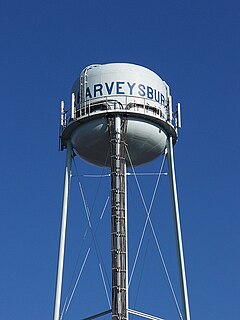
Potable water diving is diving in a tank for potable water. This is usually done for inspection and cleaning tasks. A person who is trained to do this work may be described as a potable water diver. The risks to the diver associated with potable water diving are related to the access, confined spaces and outlets for the water. The risk of contamination of the water is managed by isolating the diver in a clean dry-suit and helmet or full-face mask which are decontaminated before the dive.
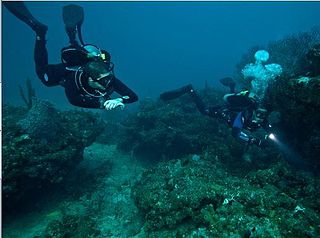
The trim of a diver is the orientation of the body in the water, determined by posture and the distribution of weight and volume along the body and equipment, as well as by any other forces acting on the diver. Both static trim and its stability affect the convenience and safety of the diver while under water and at the surface. Midwater trim is usually considered at approximately neutral buoyancy for a swimming scuba diver, and neutral buoyancy is necessary for efficient maneuvering at constant depth, but surface trim may be at significant positive buoyancy to keep the head above water.

Taliperu is a river in the Godavari system originating in the Bijapur District of Chhattisgarh. It is a left-bank tributary of Godavari River, draining into it through a confluence located near Cherla in the Khammam District in Telangana.

On March 11, 2018, a sightseeing helicopter crashed into the East River off the Upper East Side of Manhattan, New York City, killing 5 people. Two passengers died at the scene, and three others were pronounced dead at the hospital. The pilot escaped the helicopter following the crash. The aircraft was operated by Liberty Helicopters for FlyNyon. Two people were from New York state; another two were from Dallas, Texas; and the fifth was from Argentina. The pilot is from Connecticut.

Human factors in diving equipment design is the influence of the interaction between the diver and the equipment on the design of the equipment. The underwater diver relies on various items of diving and support equipment to stay alive and in reasonable comfort and to perform the planned tasks during a dive. The design of the equipment can strongly influence its effectiveness in performing the desired functions.
















